Special Report
Every State’s Rules for Reopening and Social Distancing

Published:
Last Updated:

The United States has confirmed almost 1.9 million cases of COVID-19, and more than 107,000 people have died from the coronavirus disease as of June 4.
As nationwide cases have been declining, states have also begun to loosen restrictions and open their economies — even as health experts urge caution. They are also concerned that demonstrations arising from the death of George Floyd, an African American man, while in police custody might lead to another surge in virus cases. The civil unrest erupted across the nation just as states had begun to relax stay-at-home orders and social distancing measures put in place to curb the spread of the novel coronavirus and as businesses had started reopening.
To determine each state’s social distancing measures and restrictions on movement, 24/7 Wall St. reviewed executive orders from state governors since the first COVID-19 case was confirmed in the United States at the end of January.
Click here to see every state’s rules for reopening and social distancing.
As we moved into June, many states had shifted into their next phases of reopening, many of which involve opening up restaurants for outdoor dining; allowing retailers to have limited customer visits; permitting sports activities; and allowing what had been deemed nonessential businesses to reopen.
Even though the number of new COVID-19 cases has plunged in New York City and New Jersey — the nation’s most densely-populated major city and the most densely-populated state — those two states have been slower to reopen their economies. Michigan Gov. Gretchen Whitmer, whose state was also hit hard by COVID-19, extended the state’s stay-at-home order until at least June 12.
Other states began pulling back on their restriction orders as early as late April, and seven never enacted them at all. COVID-19 daily infection rates have been increasing in two of those states, Arkansas and Utah. These are the states where the virus is growing fastest right now.
It is important to note that while confirmed new infections appear to be trending downward nationally, there are likely many thousands of people who became infected and are asymptomatic. According to the Centers for Disease Control and Prevention, there were likely thousands of undiagnosed deaths that occurred during the pandemic. This is how COVID-19 is being underreported in most states.
Alabama
> Confirmed COVID-19 cases as of June 4: 384 per 100,000 people — 22nd highest (total: 18,766)
> COVID-19 related deaths as of June 4: 13 per 100,000 people — 24th highest (total: 651)
> Tests as of June 4: 4,808 per 100,000 people — 25th lowest (total: 234,993)
> Date of first confirmed case: 3/13/2020
> Est. peak date: 4/19/2020 (est. 1,692 active infections)
> Population: 4,887,871
Schools in Alabama were allowed to reopen on June 1 and people need to maintain 6 feet social distancing. Employees at educational institutions are required to wear masks. These conditions will remain in place until July 3 at the earliest. Until July 3, Alabama is under a Safer at Home Order, which allows restaurants to offer food for takeout or delivery and maintain 6-foot social distancing protocols.
[in-text-ad]
Alaska
> Confirmed COVID-19 cases as of June 4: 68 per 100,000 people — 4th lowest (total: 505)
> COVID-19 related deaths as of June 4: 1 per 100,000 people — 2nd lowest (total: 10)
> Tests as of June 4: 7,890 per 100,000 people — 8th highest (total: 58,182)
> Date of first confirmed case: 3/12/2020
> Est. peak date: 3/18/2020 (est. 88 active infections)
> Population: 737,438
Starting on June 5, travelers arriving into Alaska from another state or country must follow new protocols: completing a traveler declaration form; presenting results of a negative COVID-19 test taken within the previous 72 hours; or taking a test upon arrival and self-quarantine until results are known. Travelers can only use road or maritime highways, and travel to remote areas is restricted to essential travel. All travelers are urged to wash hands often and wipe down surfaces, practice social distancing of 6 feet, and wearing a mask indoors.
Arizona
> Confirmed COVID-19 cases as of June 4: 310 per 100,000 people — 21st lowest (total: 22,223)
> COVID-19 related deaths as of June 4: 14 per 100,000 people — 23rd highest (total: 981)
> Tests as of June 4: 3,410 per 100,000 people — 11th lowest (total: 244,525)
> Date of first confirmed case: 1/26/2020
> Est. peak date: 4/16/2020 (est. 2,386 active infections)
> Population: 7,171,646
The Arizona Department of Education on June 1 released guidance for schools to reopen for the 2020-2021 school year. The reopening roadmap does not mandate requirements but instead offers a number of suggestions: that schools operate on intermittent schedules; that students be checked for temperatures; that schools consider reducing sizes; and possibly requiring students to wear masks.
Arkansas
> Confirmed COVID-19 cases as of June 4: 268 per 100,000 people — 16th lowest (total: 8,067)
> COVID-19 related deaths as of June 4: 5 per 100,000 people — 8th lowest (total: 142)
> Tests as of June 4: 4,728 per 100,000 people — 23rd lowest (total: 142,480)
> Date of first confirmed case: 3/11/2020
> Est. peak date: 4/14/2020 (est. 317 active infections)
> Population: 3,013,825
Arkansas was one of a handful of states to never issue a statewide stay-at-home order, but nonessential businesses were closed for a period. Establishments like gyms and barbershops began reopening in early May. Since May 11, restaurants have resumed dine-in services but with limitations — they can only seat a third of their total capacity. If cases in the state continue to decline, restaurants will be able to operate at two-thirds capacity. High school and community sports teams were allowed to resume practice events starting June 1, under strict measures. Gov. Asa Hutchinson postponed in-person graduation ceremonies until at least July 1.
[in-text-ad-2]
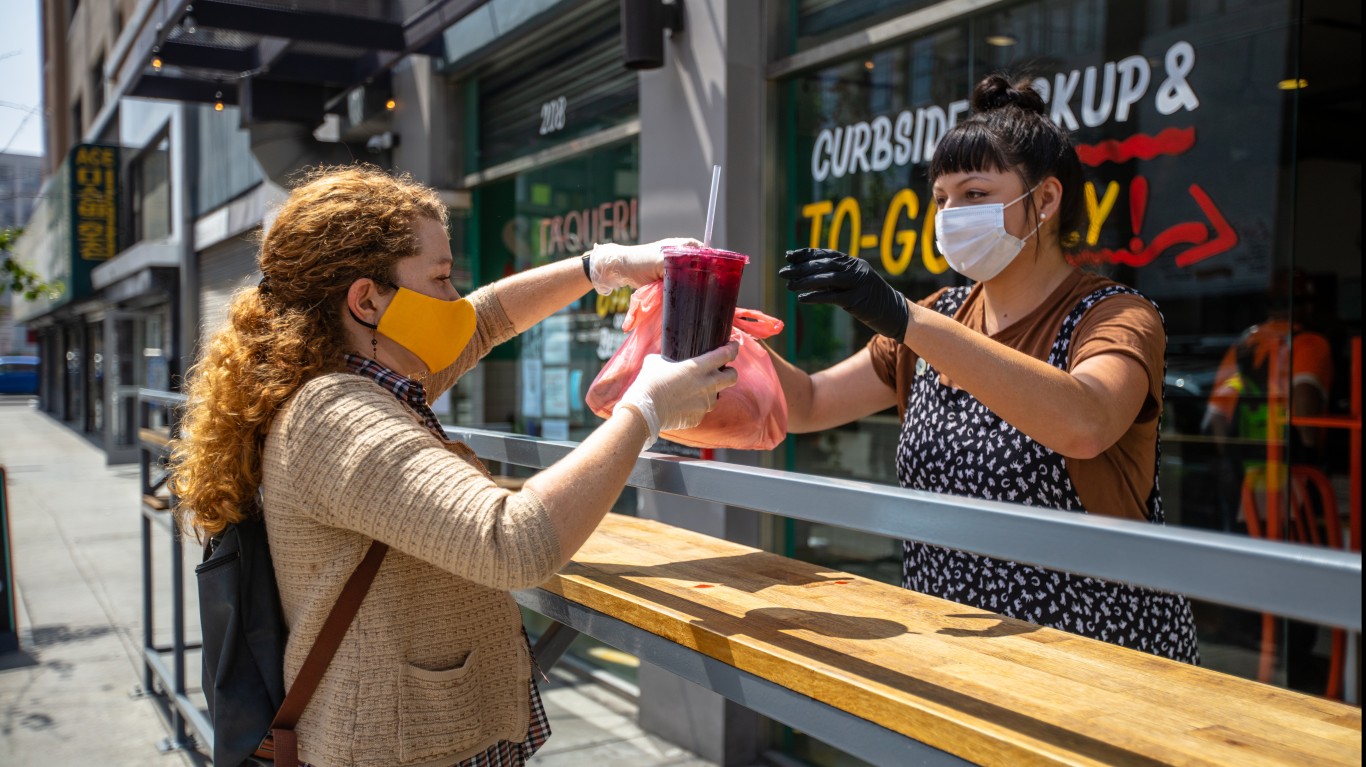
California
> Confirmed COVID-19 cases as of June 4: 298 per 100,000 people — 19th lowest (total: 117,687)
> COVID-19 related deaths as of June 4: 11 per 100,000 people — 23rd lowest (total: 4,361)
> Tests as of June 4: 5,388 per 100,000 people — 21st highest (total: 2,131,294)
> Date of first confirmed case: 1/25/2020
> Est. peak date: 4/8/2020 (est. 10,236 active infections)
> Population: 39,557,045
A stay-at-home order, which has no set end date, is still in effect, though some restrictions are being lifted. The state is reopening at the county level — with counties that meet specific criteria allowed to lift certain restrictions. An increase in COVID-19 cases in early June may delay reopening in certain counties.
California is currently in Phase 2 of its four-phase reopening, which started on May 8. This phase allows lower-risk businesses to reopen. In the later stage of Phase 2, retail, museums, and dine-in eateries were allowed to reopen with social distancing protocols. No date has been set for Phase 3, when higher-risk venues can reopen.
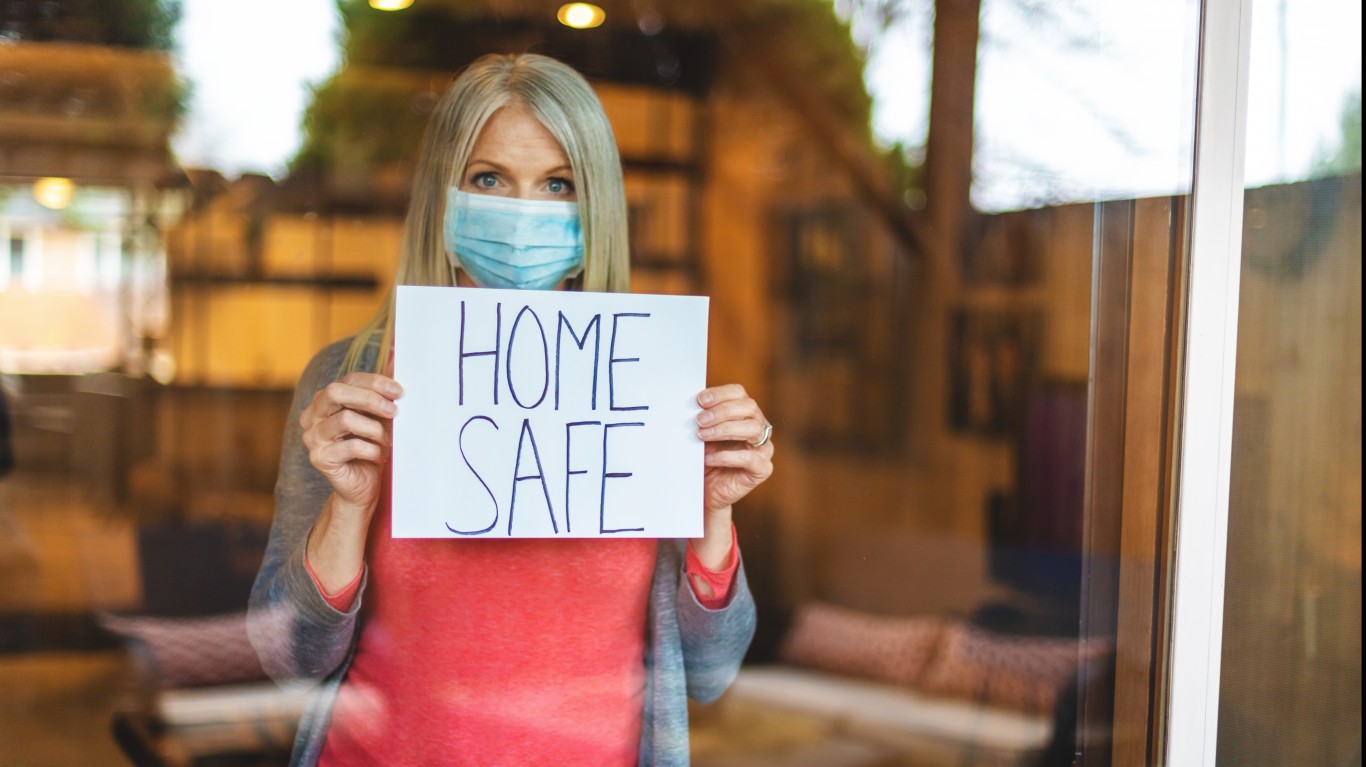
Colorado
> Confirmed COVID-19 cases as of June 4: 475 per 100,000 people — 18th highest (total: 27,060)
> COVID-19 related deaths as of June 4: 26 per 100,000 people — 13th highest (total: 1,494)
> Tests as of June 4: 3,418 per 100,000 people — 12th lowest (total: 194,697)
> Date of first confirmed case: 3/5/2020
> Est. peak date: 4/2/2020 (est. 3,909 active infections)
> Population: 5,695,564
Gov. Jared Polis signed an order on June 1 shifting Colorado to Safer at Home and in the Vast, Great Outdoors from the previous Safer at Home order. The new order now encourages people to go outside while maintaining social distancing. It also extends Safer at Home requirements like limiting public gatherings to no more than 10 people for another 30 days. People are asked to wear masks and stay 6 feet apart. Playgrounds and swimming pools are allowed to open at limited capacity.
[in-text-ad]
Connecticut
> Confirmed COVID-19 cases as of June 4: 1,206 per 100,000 people — 5th highest (total: 43,091)
> COVID-19 related deaths as of June 4: 112 per 100,000 people — 3rd highest (total: 3,989)
> Tests as of June 4: 7,680 per 100,000 people — 9th highest (total: 274,396)
> Date of first confirmed case: 3/8/2020
> Est. peak date: 4/5/2020 (est. 10,932 active infections)
> Population: 3,572,665
Connecticut announced that summer camps can reopen on June 29, in compliance with state requirements. As of June 1, barbershops, hair salons and tribal casinos were allowed to reopen. Gov. Ned Lamont’s order on limits on social gatherings was amended, and as of June 1, outdoor gatherings of up to 25 people were allowed, in compliance with social distancing protocols of 6 feet apart and wearing of masks.
Delaware
> Confirmed COVID-19 cases as of June 4: 1,008 per 100,000 people — 6th highest (total: 9,746)
> COVID-19 related deaths as of June 4: 40 per 100,000 people — 11th highest (total: 386)
> Tests as of June 4: N/A
> Date of first confirmed case: 3/11/2020
> Est. peak date: 4/17/2020 (est. 978 active infections)
> Population: 967,171
Delaware’s state museums reopened on June 1 for self-guided tours. Personal care services such as massage therapy are allowed to reopen at 30% capacity on June 8. Delaware will begin Phase 2 of reopening on June 15, with retailers, restaurants, and other establishments allowed to expand to 60% capacity from 30% during Phase 1.
Florida
> Confirmed COVID-19 cases as of June 4: 283 per 100,000 people — 17th lowest (total: 60,183)
> COVID-19 related deaths as of June 4: 12 per 100,000 people — 24th lowest (total: 2,607)
> Tests as of June 4: 5,202 per 100,000 people — 22nd highest (total: 1,107,952)
> Date of first confirmed case: 3/1/2020
> Est. peak date: 4/1/2020 (est. 4,674 active infections)
> Population: 21,299,325
Gov. Ron DeSantis announced Phase 2 of the reopening of Florida’s economy on June 3. Under Phase 2, bars and pubs may operate at 50% capacity inside and full capacity outside for dine-in service. Movie theaters and entertainment venues can operate at 50% capacity also. Restrictions on salons and barbershops. All Florida counties, except Miami-Dade, Broward, and Palm Beach, enter Phase 2 on June 5.
The easing of restrictions comes as the number of new COVID-19 cases has been rising in Florida. The state Department of Health reported an increase in new cases every day this week beginning on June 1.
[in-text-ad-2]
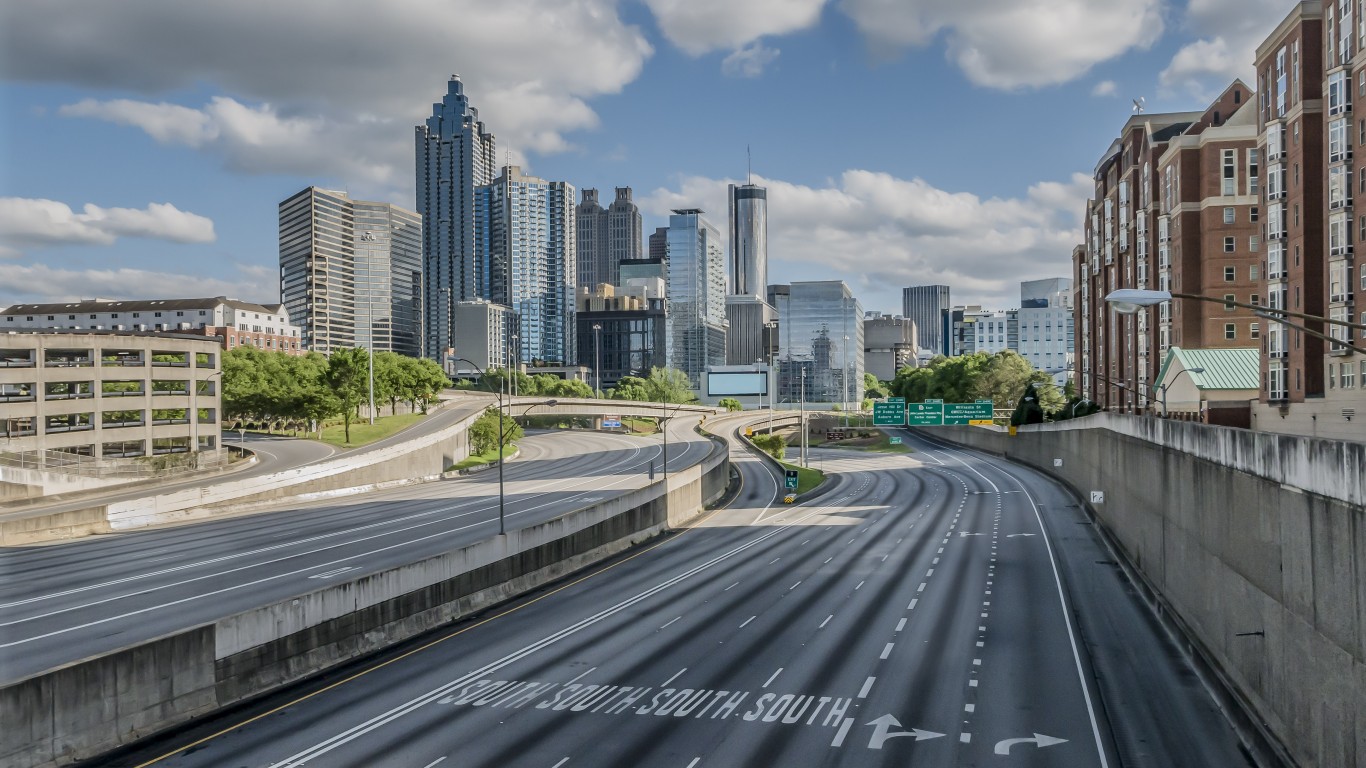
Georgia
> Confirmed COVID-19 cases as of June 4: 466 per 100,000 people — 19th highest (total: 49,028)
> COVID-19 related deaths as of June 4: 20 per 100,000 people — 15th highest (total: 2,139)
> Tests as of June 4: 5,455 per 100,000 people — 20th highest (total: 573,816)
> Date of first confirmed case: 3/2/2020
> Est. peak date: 4/1/2020 (est. 5,222 active infections)
> Population: 10,519,475
Though the shelter-in-place order expired on April 30, older state residents and other at-risk individuals remain under shelter-in-place orders until June 12. Additionally, all Georgians are encouraged to remain home whenever possible and to maintain a distance of at least 6 feet in public. Gatherings of 25 people or more were allowed in Georgia as of June, provided social distancing is maintained. Gov. Brian Kemp permitted operators of amusement park rides, carnivals, circuses, and water parks to open beginning June 12 in compliance with health requirements.
Hawaii
> Confirmed COVID-19 cases as of June 4: 46 per 100,000 people — 2nd lowest (total: 653)
> COVID-19 related deaths as of June 4: 1 per 100,000 people — the lowest (total: 17)
> Tests as of June 4: 3,982 per 100,000 people — 15th lowest (total: 56,569)
> Date of first confirmed case: 3/6/2020
> Est. peak date: 3/27/2020 (est. 76 active infections)
> Population: 1,420,491
The state is lifting the requirement to quarantine for 14 days for travel between islands on June 16 but is requiring thermal screening at the airport. Travelers may be prevented from flying if they have a temperature above 100.4 degrees Fahrenheit.
Beaches are open for recreational activities and as long as social distance is maintained. Malls, car washes, nonemergency medical visits, and retailers are allowed to reopen.
[in-text-ad]
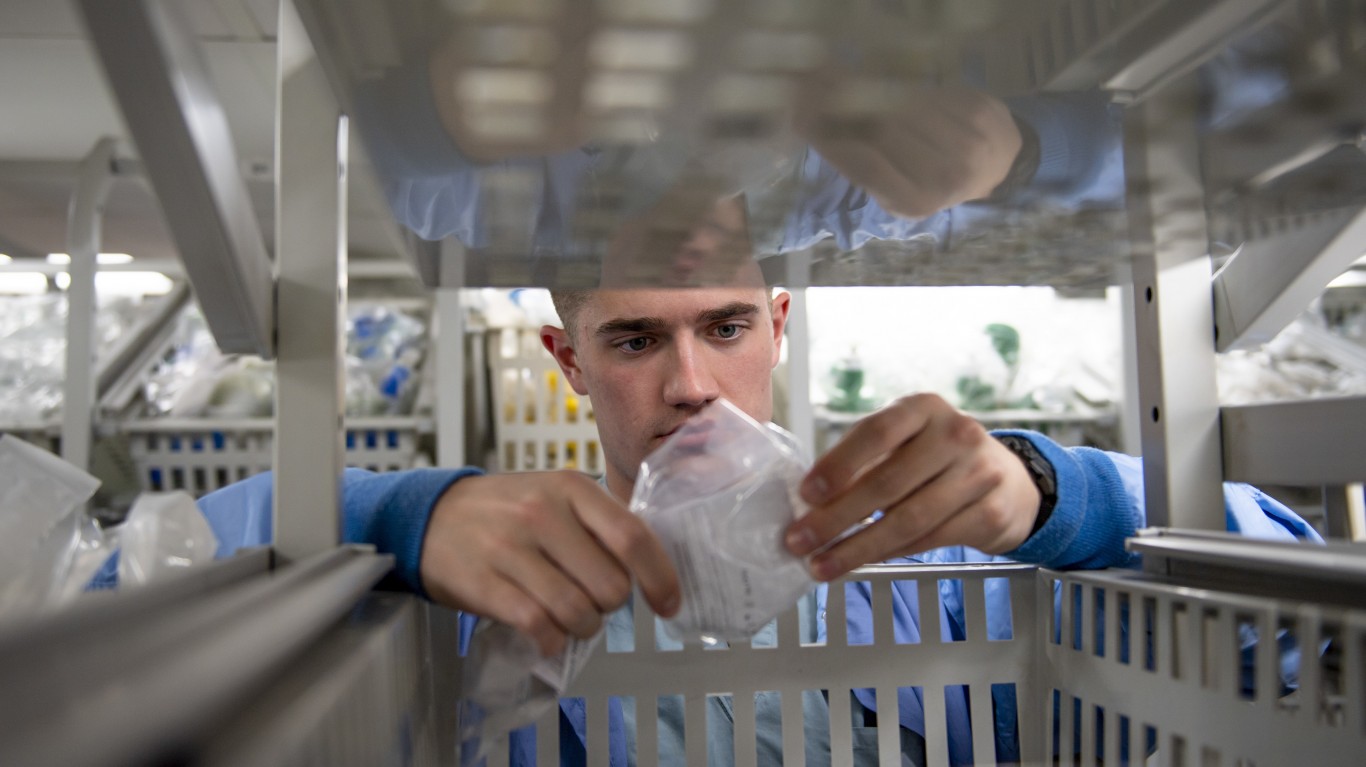
Idaho
> Confirmed COVID-19 cases as of June 4: 170 per 100,000 people — 9th lowest (total: 2,990)
> COVID-19 related deaths as of June 4: 5 per 100,000 people — 9th lowest (total: 83)
> Tests as of June 4: 2,823 per 100,000 people — 8th lowest (total: 49,524)
> Date of first confirmed case: 3/13/2020
> Est. peak date: 3/27/2020 (est. 311 active infections)
> Population: 1,754,208
Idaho entered Phase 3 of its four-phase reopening plan on May 30 and that is scheduled to end on June 12. Gatherings of up to 50 people are allowed where social distancing is practiced. Nonessential travel is permitted. Bars and movie theaters can reopen if they meet safety protocols. Nightclubs remain closed. The state encourages travelers from out of state to self-quarantine in Idaho for 14 days.
The state still encourages face mask use and maintaining 6 feet of distance from others in public.
Illinois
> Confirmed COVID-19 cases as of June 4: 972 per 100,000 people — 7th highest (total: 123,830)
> COVID-19 related deaths as of June 4: 44 per 100,000 people — 10th highest (total: 5,621)
> Tests as of June 4: 7,528 per 100,000 people — 10th highest (total: 959,175)
> Date of first confirmed case: 1/24/2020
> Est. peak date: 4/25/2020 (est. 13,243 active infections)
> Population: 12,741,080
Restaurants began to reopen in Chicago on June 3 for outside dining only. Retail shops, salons, and barbershops were permitted to open as well, though subject to reduced capacity, and workers and customers must wear face coverings over their nose and mouth.
Illinois is one of the hardest-hit states by the virus with Covid-19 deaths topping 5,000 on June 3.
Indiana
> Confirmed COVID-19 cases as of June 4: 534 per 100,000 people — 17th highest (total: 35,712)
> COVID-19 related deaths as of June 4: 30 per 100,000 people — 12th highest (total: 2,032)
> Tests as of June 4: 4,152 per 100,000 people — 19th lowest (total: 277,815)
> Date of first confirmed case: 3/6/2020
> Est. peak date: 4/5/2020 (est. 4,933 active infections)
> Population: 6,691,878
Indiana moved to Phase 3 beginning May 22 and allowed gatherings of up to 100 people. Gyms and fitness centers were allowed to reopen on June 1. Outside, people must maintain a 6-foot distance from others and are encouraged to wear face coverings. Retail stores and malls may expand to 75% capacity and must maintain social distancing rules. Community pools and campgrounds may reopen, and recreational sports leagues may resume practice. Contact sports such as football, basketball, and wrestling are not permitted.
[in-text-ad-2]
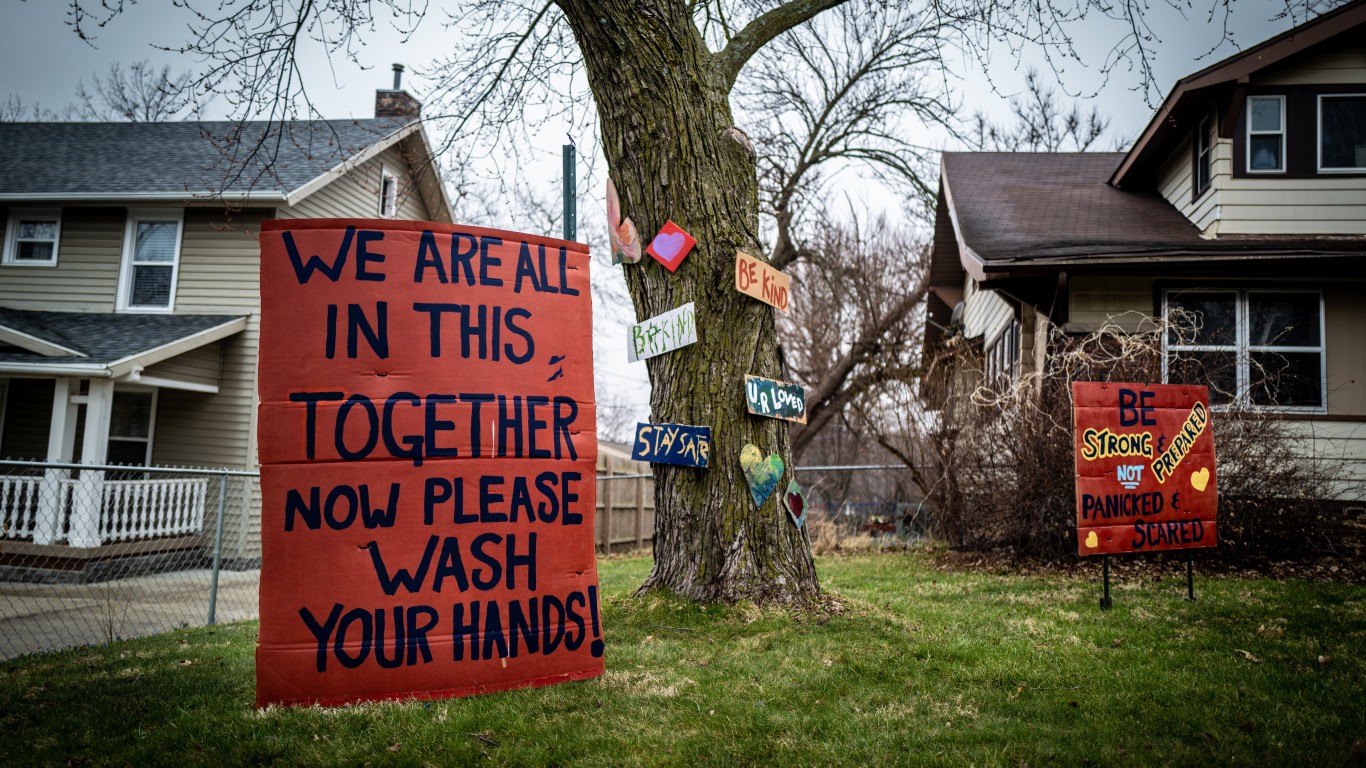
Iowa
> Confirmed COVID-19 cases as of June 4: 634 per 100,000 people — 11th highest (total: 20,010)
> COVID-19 related deaths as of June 4: 18 per 100,000 people — 19th highest (total: 566)
> Tests as of June 4: 5,200 per 100,000 people — 23rd highest (total: 164,134)
> Date of first confirmed case: 3/8/2020
> Est. peak date: 5/8/2020 (est. 1,637 active infections)
> Population: 3,156,145
Iowa’s speedways, racetracks, and amphitheaters were allowed to reopen on June 1. Casinos were also allowed to reopen, as well as amusement parks, bowling alleys, pool halls, and arcades. These venues were allowed to reopen at 50% capacity and maintain social distancing requirements. Employees at the casinos are required to wear masks and be stationed behind Plexiglas. Hand sanitizers are to be located throughout the casinos. Gambling venues must restrict the number of patrons on the gaming floor and waging area to 50% of capacity and maintain social distancing measures of 6 feet.
Kansas
> Confirmed COVID-19 cases as of June 4: 349 per 100,000 people — 25th lowest (total: 10,170)
> COVID-19 related deaths as of June 4: 8 per 100,000 people — 14th lowest (total: 222)
> Tests as of June 4: N/A
> Date of first confirmed case: 3/7/2020
> Est. peak date: 3/26/2020 (est. 696 active infections)
> Population: 2,911,510
The second phase of the reopening began May 22 and will last through June 7. Restaurants can open if they maintain social distancing requirements and limit crowds. Hair salons, gyms, casinos, museums, and theaters remain closed. Organized sports, community swimming pools, festivals, parades, and graduation ceremonies are not allowed. Gatherings of more than 15 people are prohibited. Bars and restaurants must preserve a 6-foot distance between tables, booths, and barstools. Casinos and indoor leisure spaces can open as well.
Phase 2 is scheduled to last until June 7. After that date, gatherings of up to 45 people will be permitted, and nonessential travel may resume.
[in-text-ad]
Kentucky
> Confirmed COVID-19 cases as of June 4: 233 per 100,000 people — 13th lowest (total: 10,410)
> COVID-19 related deaths as of June 4: 10 per 100,000 people — 20th lowest (total: 450)
> Tests as of June 4: 5,196 per 100,000 people — 24th highest (total: 232,199)
> Date of first confirmed case: 3/6/2020
> Est. peak date: 3/27/2020 (est. 1,324 active infections)
> Population: 4,468,402
Movie theaters and fitness centers were allowed to reopen on June 1, and museums, outdoor attractions, aquariums, libraries, and distilleries may reopen on June 8. Campgrounds can reopen on June 11 as can child care services, with reduced capacity, on June 15. Venues such as bars that hold 50 or fewer people, and gatherings of up to 50 people, can reopen starting June 29, depending on whether they meet safety criteria. Businesses that were permitted to operate at 33% capacity beginning May 22 will be allowed to increase that capacity to 50% on June 22, provided they comply with guidelines.
Louisiana
> Confirmed COVID-19 cases as of June 4: 883 per 100,000 people — 9th highest (total: 41,133)
> COVID-19 related deaths as of June 4: 59 per 100,000 people — 6th highest (total: 2,759)
> Tests as of June 4: 8,629 per 100,000 people — 7th highest (total: 402,087)
> Date of first confirmed case: 3/9/2020
> Est. peak date: 3/24/2020 (est. 7,882 active infections)
> Population: 4,659,978
The stay-at-home order expired on May 15 and the state entered Phase 1 of reopening, which will last at least through June 5. Some restrictions will stay in place. Everyone in Louisiana should wear masks when in public. Banks, gas stations, and veterinary services are open. Restaurants can open at 25% capacity. They need to have 6 feet between customers and 10 feet between tables. Gatherings are limited to 10 people. Movie theaters, places of worship, and gyms can reopen with strict physical distancing protocols.
When Louisiana shifts to Phase 2 on June 5, places of worship can expand to 50% capacity with social distancing, and businesses such as massage and tattoo parlors, spas, bars bowling alleys, and wedding venues can open with reduced capacity.
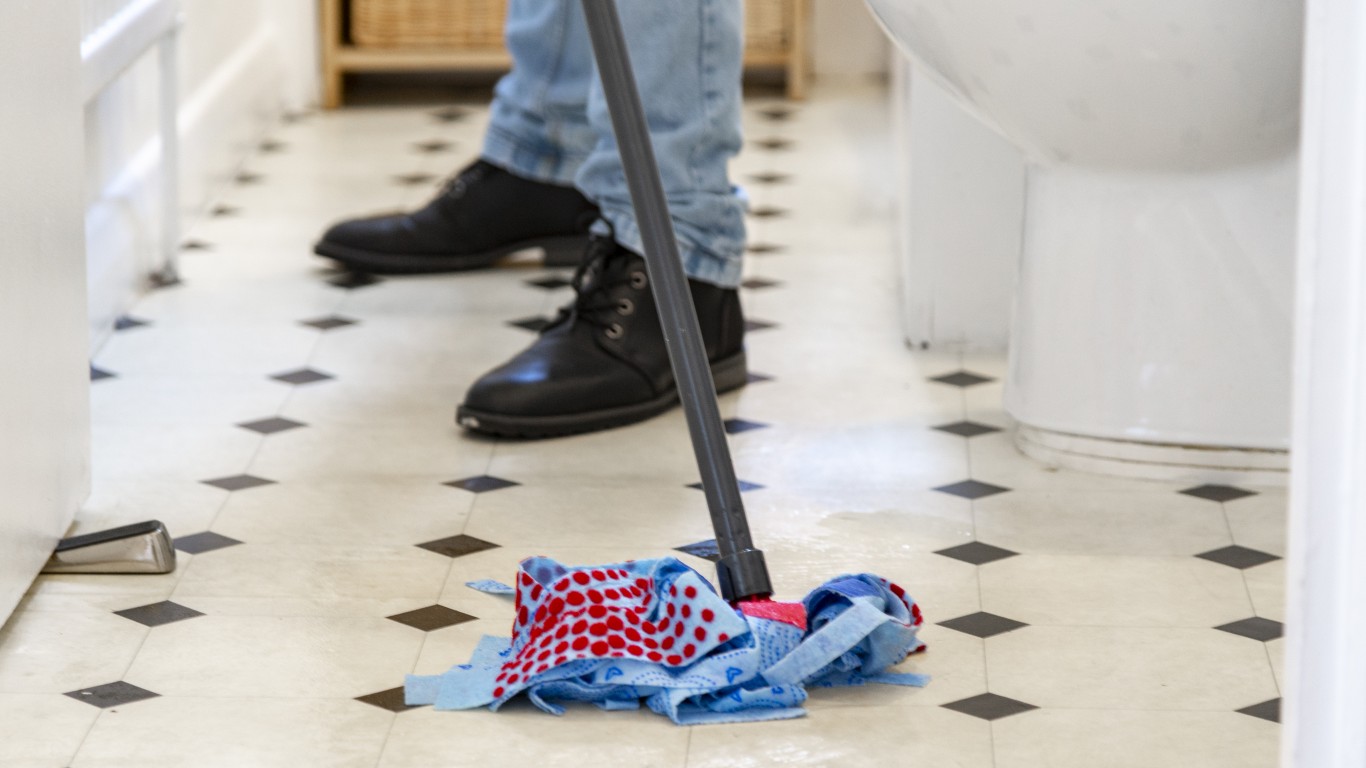
Maine
> Confirmed COVID-19 cases as of June 4: 00 per 100,000 people — the lowest (total: 02)
> COVID-19 related deaths as of June 4: 7 per 100,000 people — 13th lowest (total: 95)
> Tests as of June 4: 4,127 per 100,000 people — 18th lowest (total: 55,237)
> Date of first confirmed case: 3/12/2020
> Est. peak date: 3/31/2020 (est. 204 active infections)
> Population: 1,338,404
Another phase of Maine’s reopening began in June, as fitness centers and retail stores were allowed to reopen. Restaurants in York, Cumberland, and Androscoggin counties opened for outdoor dining service on June 1. Dine-in service is not permitted. Dine-in and outdoor service was permitted in Penobscot County starting June 1. Maine lodging providers began accepting reservations for stays with an arrival date of June 1 or later for Maine residents and for non-residents who comply with the state’s 14-day self-quarantine mandate. Gatherings of people were increased to 50 from 10 as of June 1.
[in-text-ad-2]
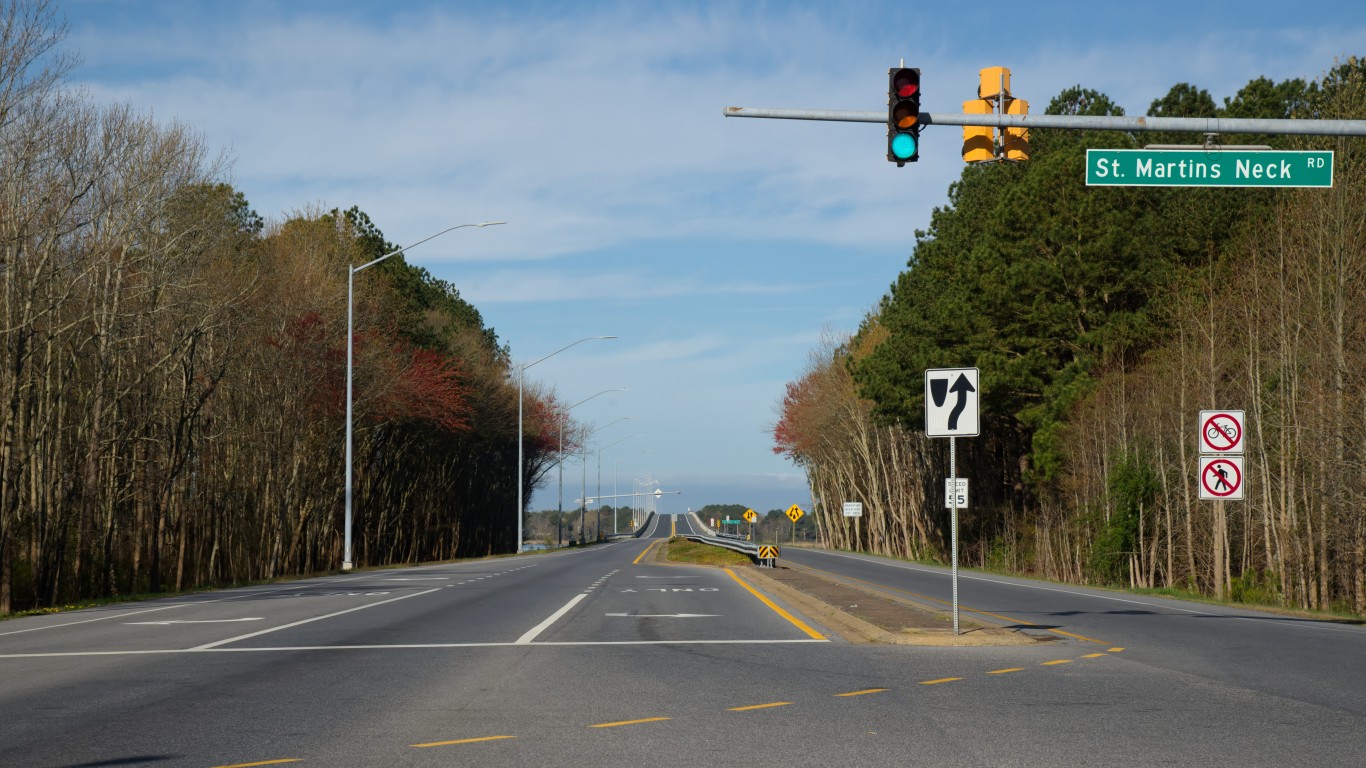
Maryland
> Confirmed COVID-19 cases as of June 4: 924 per 100,000 people — 8th highest (total: 55,858)
> COVID-19 related deaths as of June 4: 44 per 100,000 people — 9th highest (total: 2,668)
> Tests as of June 4: N/A
> Date of first confirmed case: 3/5/2020
> Est. peak date: 4/6/2020 (est. 6,509 active infections)
> Population: 6,042,718
Maryland is shifting to Phase 2 of its reopening plan on June 5 by lifting the order requiring the closing of nonessential businesses. The businesses include retail shops, specialty vendors, information technology companies, design studios, advertising and architectural firms, and media production companies, among others.
Employees able to telework are encouraged to continue to do so. Other guidance from the state for the workplace includes wearing face coverings; conducting temperature checks for workers; implementing split schedules; and staggering shifts.
Massachusetts
> Confirmed COVID-19 cases as of June 4: 1,472 per 100,000 people — 3rd highest (total: 101,592)
> COVID-19 related deaths as of June 4: 104 per 100,000 people — 4th highest (total: 7,152)
> Tests as of June 4: 8,898 per 100,000 people — 6th highest (total: 614,133)
> Date of first confirmed case: 2/1/2020
> Est. peak date: 4/7/2020 (est. 20,125 active infections)
> Population: 6,902,149
Gov. Charlie Baker issued an executive order on June 1 that detailed the businesses that can open in the state’s reopening plan. Retailers will transition to browsing and in-store transactions with restrictions from curbside pickup and delivery-only at the start of Phase 2, which started on June 1. Occupancy will be limited to eight people per 1,000 square feet of indoor space, or 40% of occupancy.
Organized sports programs will be conducted under provisions such as limiting contact sports to no-contact drills and practices and separating participants into groups of 10 or fewer.
Restaurants are allowed to provide outdoor dining service at the start of Phase 2 and may be allowed indoor dining depending on local health data.
[in-text-ad]
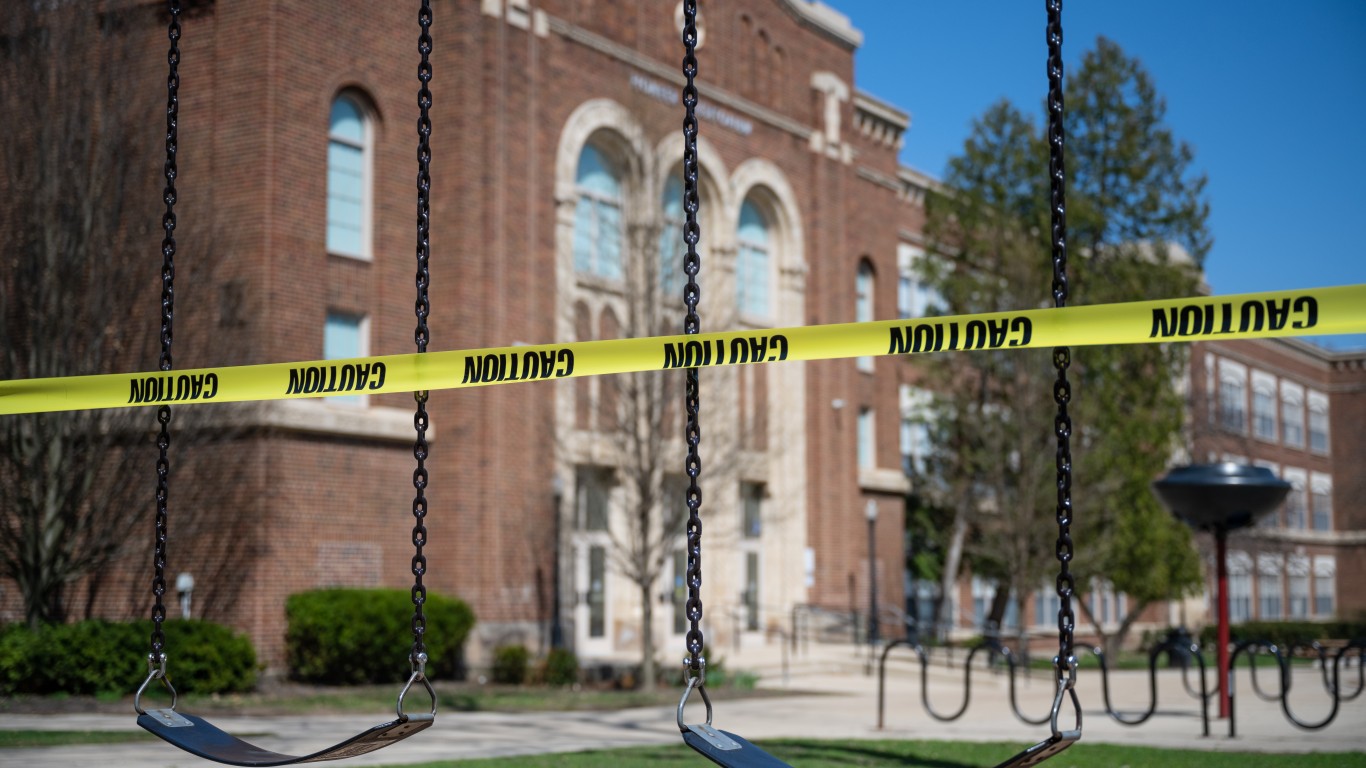
Michigan
> Confirmed COVID-19 cases as of June 4: 581 per 100,000 people — 13th highest (total: 58,035)
> COVID-19 related deaths as of June 4: 56 per 100,000 people — 7th highest (total: 5,570)
> Tests as of June 4: 6,073 per 100,000 people — 14th highest (total: 607,085)
> Date of first confirmed case: 3/10/2020
> Est. peak date: 3/27/2020 (est. 15,179 active infections)
> Population: 9,995,915
The stay-at-home order was extended in Michigan until at least June 12. The order also extends the closure of public venues like theaters, gyms, and casinos. Michigan allowed retailers and auto dealerships to reopen on May 26. Effective May 29, the state lifted the requirement that health care providers postpone some nonessential medical, dental, and veterinary procedures.
Retailers are allowed to open beginning June 4 and restaurants after June 8, but with capacity limits. Swimming pools, libraries, museums and day camps for children can open after June 8 as well. Groups of up to 100 people have been allowed to gather outdoors while social distancing since June 1. Indoor gatherings are limited to 10 people at most. Office work that cannot be performed remotely can resume, as well as in-home services such as house cleaning.

Minnesota
> Confirmed COVID-19 cases as of June 4: 461 per 100,000 people — 20th highest (total: 25,870)
> COVID-19 related deaths as of June 4: 19 per 100,000 people — 18th highest (total: 1,086)
> Tests as of June 4: 4,736 per 100,000 people — 24th lowest (total: 265,718)
> Date of first confirmed case: 3/6/2020
> Est. peak date: 4/20/2020 (est. 2,847 active infections)
> Population: 5,611,179
The stay-at-home order expired on May 17. Some recreational activities, including golfing, boating, fishing, hunting, and hiking have been allowed to resume since April 18. Industrial jobs that are not customer-facing can resume if social distancing and sanitary procedures are in place. Employees who can work from home should continue to do so. Retail stores, malls, and other nonessential street businesses can reopen at 50% occupancy and if they follow physical distancing guidelines.
Starting May 27, places of worship have been allowed to open at 25% capacity. Gatherings in outdoor settings are limited to a maximum of 250 people. Salons, and barbershops can now open with restrictions. Restaurants and bars can offer outdoor service with restrictions.
Mississippi
> Confirmed COVID-19 cases as of June 4: 547 per 100,000 people — 15th highest (total: 16,322)
> COVID-19 related deaths as of June 4: 26 per 100,000 people — 14th highest (total: 782)
> Tests as of June 4: 6,172 per 100,000 people — 13th highest (total: 184,335)
> Date of first confirmed case: 3/11/2020
> Est. peak date: 4/30/2020 (est. 1,871 active infections)
> Population: 2,986,530
Mississippi’s safer-at-home order ended June 1 and has been replaced by a safe return order, which is effective until June 15. Social gatherings must comply with social distancing requirements, with a limit of 50 people indoors and no more than 100 people outdoors. Gatherings where people cannot socially distance have limits of 20 people indoors and up to 50 people outside.
Health care procedures can return as before, but hospitals have to set aside at least 25% of capacity for COVID-19 patients. School buildings will also be able to open for summer programs. All businesses and nonprofits can open in line with health guidance, but employees are encouraged to keep working from home. Bars that do not serve food are allowed to reopen. Restaurants and bars can now have live music performances, with customers and musicians maintaining at least a 12-foot distance. Indoor places of amusement such as bowling alleys and playgrounds can open at 50% capacity.
[in-text-ad-2]
Missouri
> Confirmed COVID-19 cases as of June 4: 225 per 100,000 people — 11th lowest (total: 13,767)
> COVID-19 related deaths as of June 4: 13 per 100,000 people — 25th highest (total: 786)
> Tests as of June 4: 3,446 per 100,000 people — 14th lowest (total: 211,118)
> Date of first confirmed case: 3/7/2020
> Est. peak date: 4/14/2020 (est. 1,757 active infections)
> Population: 6,126,452
Missouri’s stay at home order ended May 4. Gov. Mike Parson said on May 28 that he was extending the first phase of his reopening plan through June 15. Phase 1 requires social distancing of 6 feet. Some businesses also are required to put limits on indoor occupancy.
Phase 2 will allow the maximum number of people gathering in one place to increase to 50 people from 10. Also in Phase 2, businesses such as restaurants, places of worship, gyms, and salons may boost operations to 50% capacity as long as social distancing is followed.
Montana
> Confirmed COVID-19 cases as of June 4: 49 per 100,000 people — 3rd lowest (total: 525)
> COVID-19 related deaths as of June 4: 2 per 100,000 people — 3rd lowest (total: 17)
> Tests as of June 4: 4,090 per 100,000 people — 16th lowest (total: 43,448)
> Date of first confirmed case: 3/13/2020
> Est. peak date: 3/12/2020 (est. 98 active infections)
> Population: 1,062,305
The shelter-in-place order expired April 26. Phase 2 of reopening started on June 1, and gatherings are now limited to a maximum of 50 people. Also on June 1, restaurants, bars, breweries distilleries, and casinos can now expand to 75% capacity. Gyms, indoor group fitness classes, pools, and hot tubs can also operate at 75% capacity. Concert halls, bowling alleys, and other places of assembly can resume activities but with reduced capacity. The 24-person cap per child care facility has been lifted. Employers should still allow employees to work remotely as much as possible.
[in-text-ad]
Nebraska
> Confirmed COVID-19 cases as of June 4: 771 per 100,000 people — 10th highest (total: 14,866)
> COVID-19 related deaths as of June 4: 10 per 100,000 people — 19th lowest (total: 189)
> Tests as of June 4: 5,827 per 100,000 people — 16th highest (total: 112,409)
> Date of first confirmed case: 2/17/2020
> Est. peak date: 5/8/2020 (est. 582 active infections)
> Population: 1,929,268
The state never issued a stay-at-home order. People returning from international travel are required to self-quarantine for 14 days. Restaurants can open in certain regions and at 50% capacity. All dining parties are restricted to no more than six people. Child care facilities can now open and have up to 15 children per room. Hair salons, nail salons, tattoo parlors, and massage therapists may reopen but can’t allow more than 10 people in, and everyone, including patrons, must wear masks.
Nebraska is permitting youth baseball and softball teams to practice starting June 1, and games may be played starting June 18. Schools can open their weight rooms for use by student athletes after June 1.
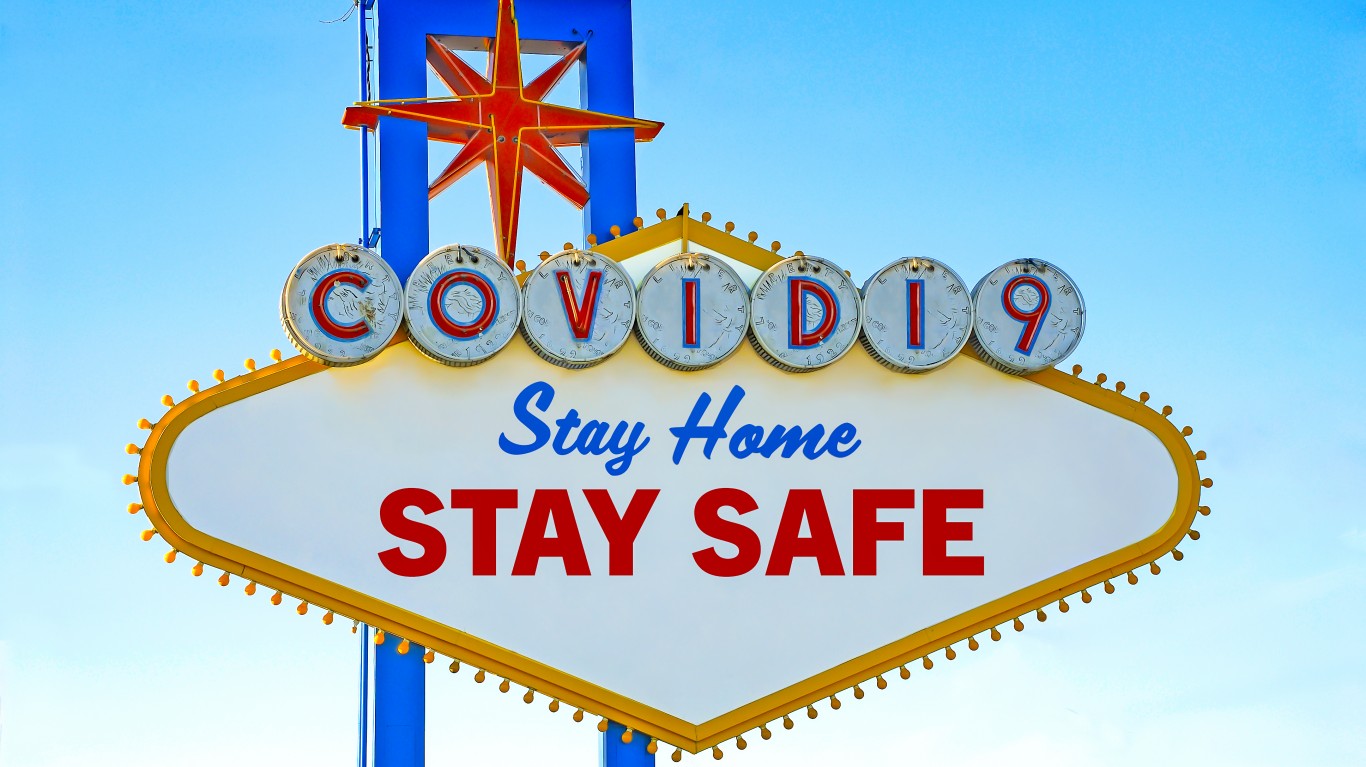
Nevada
> Confirmed COVID-19 cases as of June 4: 264 per 100,000 people — 15th lowest (total: 8,000)
> COVID-19 related deaths as of June 4: 13 per 100,000 people — 25th lowest (total: 387)
> Tests as of June 4: 3,313 per 100,000 people — 10th lowest (total: 100,540)
> Date of first confirmed case: 3/5/2020
> Est. peak date: 3/25/2020 (est. 1,132 active infections)
> Population: 3,034,392
The stay-at-home order expired on May 15, but some restrictions had already been lifted even before. The state began Phase 2 of reopening on May 29, allowing salons and tattoo parlors to open. Pools, museums, zoos, malls, bowling alleys, movie theaters, and more were also allowed to reopen with reduced capacity.
Nevada’s lifeblood, the gaming industry, reopened on June 4. Live events such as sports, concerts, and theater performances may be held for broadcast, with no in-person spectators allowed.
New Hampshire
> Confirmed COVID-19 cases as of June 4: 353 per 100,000 people — 24th highest (total: 4,795)
> COVID-19 related deaths as of June 4: 20 per 100,000 people — 17th highest (total: 265)
> Tests as of June 4: 5,600 per 100,000 people — 18th highest (total: 75,965)
> Date of first confirmed case: 3/2/2020
> Est. peak date: 4/29/2020 (est. 740 active infections)
> Population: 1,356,458
An amended stay-at-home order expired on May 31. People must maintain at least 6 feet distance when outside, use proper hand hygiene, and wear a mask whenever possible. Elective medical procedures have resumed. Services like salons, massage therapy centers, and tattoo shops can reopen beginning in June. Hotels and short-term rentals can resume service on June 5 for state residents. Out-of-state travelers have to be quarantined for 14 days when coming to New Hampshire.
[in-text-ad-2]
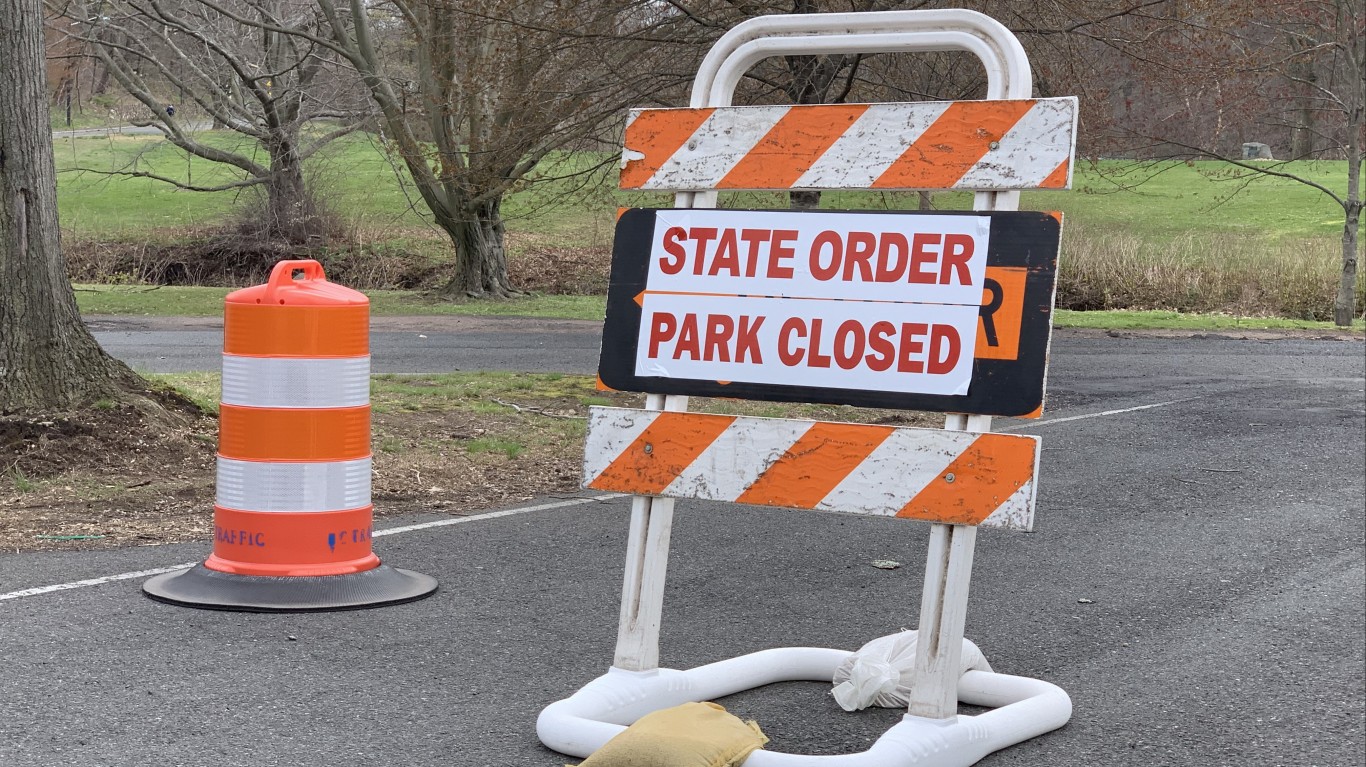
New Jersey
> Confirmed COVID-19 cases as of June 4: 1,819 per 100,000 people — 2nd highest (total: 162,068)
> COVID-19 related deaths as of June 4: 133 per 100,000 people — the highest (total: 11,880)
> Tests as of June 4: 9,400 per 100,000 people — 5th highest (total: 837,420)
> Date of first confirmed case: 3/4/2020
> Est. peak date: 3/31/2020 (est. 32,287 active infections)
> Population: 8,908,520
New Jersey’s stay-at-home order is in effect through June 5. The state is still in Phase 1 of the reopening process. Under current rules, public parks have reopened, as well as beaches and curbside retail. In the next phase, certain restrictions on retail, restaurants, museums, and libraries will be lifted. Still, operations will be on a significantly limited basis.
The outdoor gatherings’ limit is now 25, up from 10. Recreational campgrounds can reopen with social distancing measures in place. Indoor gatherings remain limited to 10 people. Horse racetracks are now open but without spectators. Phase 2 of reopening begins June 5 with restrictions on businesses being lifted as early as June 15.
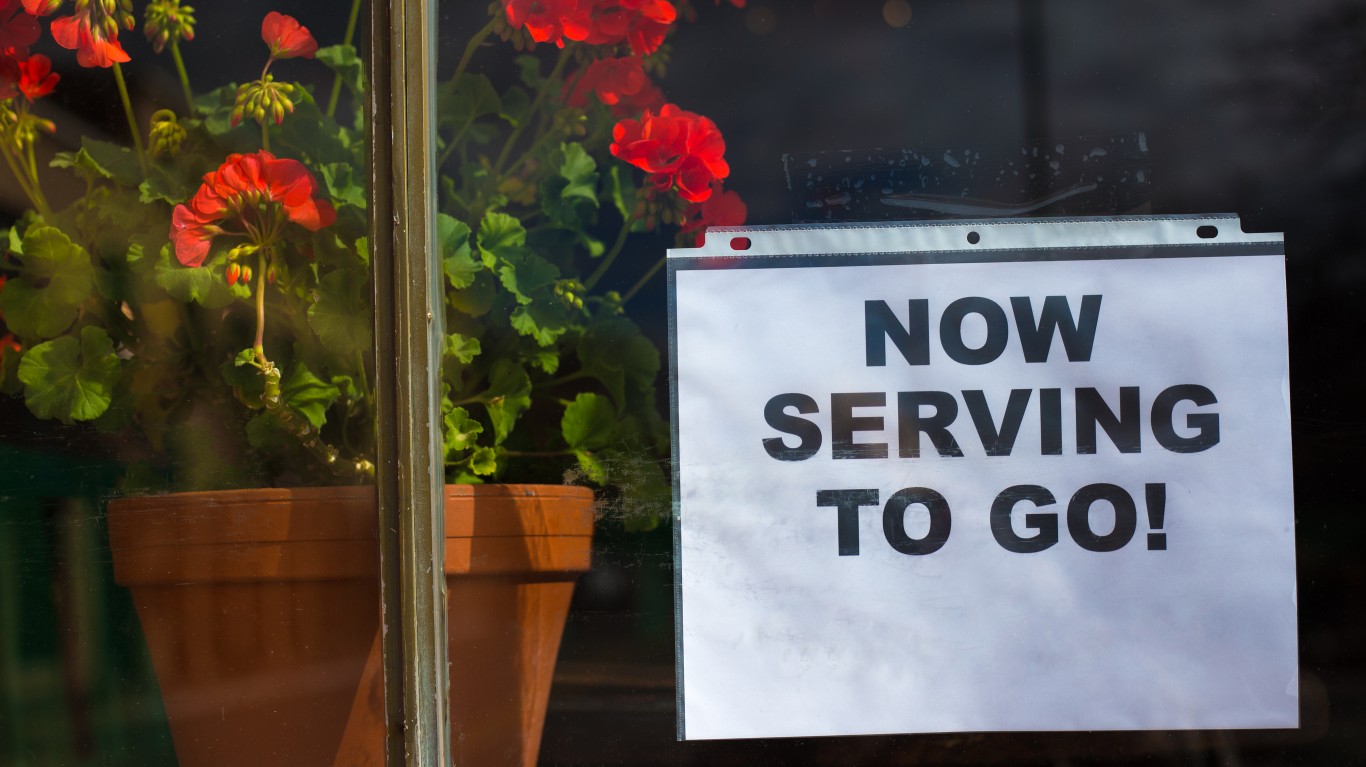
New Mexico
> Confirmed COVID-19 cases as of June 4: 388 per 100,000 people — 21st highest (total: 8,140)
> COVID-19 related deaths as of June 4: 18 per 100,000 people — 20th highest (total: 375)
> Tests as of June 4: 10,165 per 100,000 people — 3rd highest (total: 212,996)
> Date of first confirmed case: 3/11/2020
> Est. peak date: 4/17/2020 (est. 983 active infections)
> Population: 2,095,428
A modified stay-at-home order expired on May 31. Some nonessential businesses and services, including retailers, are now allowed to reopen at 25% capacity. Gatherings of more than five people are not allowed. Retailers with large stores have to limit capacity to 20%.
Gov. Michelle Lujan Grisham recently announced that starting June 1, restaurants would be allowed to resume indoor seating at 50% capacity. Gyms would also be allowed to reopen and operate at 50%. Malls, barbershops, and tattoo parlors would be able to operate at 25% capacity. Restaurants in most of the state can now offer limited outdoor dine-in service. Tables must be at least 6 feet apart, and each table can have no more than six customers. Many state parks are now open for day use.
[in-text-ad]
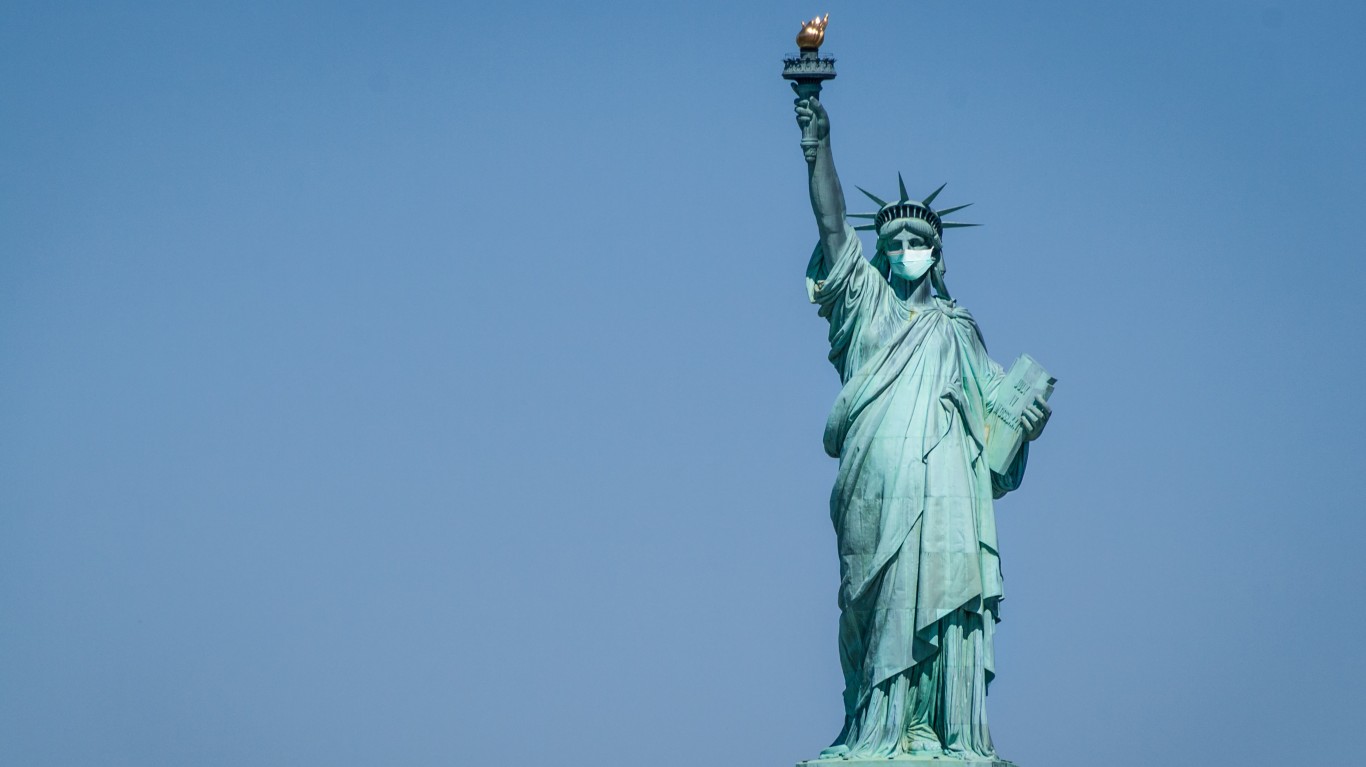
New York
> Confirmed COVID-19 cases as of June 4: 1,914 per 100,000 people — the highest (total: 374,085)
> COVID-19 related deaths as of June 4: 123 per 100,000 people — 2nd highest (total: 24,079)
> Tests as of June 4: 11,409 per 100,000 people — 2nd highest (total: 2,229,473)
> Date of first confirmed case: 3/1/2020
> Est. peak date: 3/25/2020 (est. 108,815 active infections)
> Population: 19,542,209
Though limited reopenings began in certain regions on May 15, the statewide stay-at-home order expired on May 28 with social distancing rules remaining in place. Low-risk businesses and recreational activities such as landscaping and gardening, drive-in movie theaters, and tennis can resume. Nonessential gatherings of any size are still banned. However, religious gatherings limited to 10 people were allowed to resume starting May 21. Construction, manufacturing, wholesale trade, retail (for curbside pickup only), agriculture, forestry, and fishing can resume operations. Businesses can deny entry to people without masks. Campgrounds and RV parks are now allowed to reopen statewide. As of May 26, veterinarian practices can reopen in all regions of the state.
New York City — the epicenter of the coronavirus in the United States — will not begin the process of reopening until June 8.
North Carolina
> Confirmed COVID-19 cases as of June 4: 296 per 100,000 people — 18th lowest (total: 30,777)
> COVID-19 related deaths as of June 4: 9 per 100,000 people — 18th lowest (total: 939)
> Tests as of June 4: 4,327 per 100,000 people — 20th lowest (total: 449,263)
> Date of first confirmed case: 3/3/2020
> Est. peak date: 4/6/2020 (est. 2,132 active infections)
> Population: 10,383,620
North Carolina entered its first phase of reopening on May 8, allowing retailers to operate at 50% capacity and child care centers to reopen. The modified stay-at-home order expired on May 22, when the state entered Phase 2. Under the new rules, gatherings of up to 10 people indoors and 25 people outdoors are allowed. The state also advises residents to maintain at least 6 feet of distance from others in public and wear a face mask. Restaurants are now open but must operate at reduced capacity and follow strict sanitation and social distancing guidelines. Currently, Phase 2 is set to expire on June 26.
North Dakota
> Confirmed COVID-19 cases as of June 4: 352 per 100,000 people — 25th highest (total: 2,679)
> COVID-19 related deaths as of June 4: 9 per 100,000 people — 16th lowest (total: 66)
> Tests as of June 4: 9,802 per 100,000 people — 4th highest (total: 74,502)
> Date of first confirmed case: 3/11/2020
> Est. peak date: 4/22/2020 (est. 171 active infections)
> Population: 760,077
North Dakota is one of a handful of states that never issued a statewide stay-at-home order. The order for all nonessential businesses to close ended on April 30. Some businesses, including movie theaters, gyms, salons, tattoo parlors, bars, and restaurants have been allowed to open. The state moved from the moderate to low-risk level on May 29. Bars and restaurants are now allowed to increase capacity to 75%, movie theaters are allowed to increase capacity to 65%, and fitness centers may consider resuming classes with social distancing. The recommended capacity for banquets and weddings increased to 75% of venue occupancy, but to no more than 500 people.
[in-text-ad-2]

Ohio
> Confirmed COVID-19 cases as of June 4: 315 per 100,000 people — 22nd lowest (total: 36,792)
> COVID-19 related deaths as of June 4: 20 per 100,000 people — 16th highest (total: 2,299)
> Tests as of June 4: N/A
> Date of first confirmed case: 3/9/2020
> Est. peak date: 4/20/2020 (est. 4,752 active infections)
> Population: 11,689,442
The modified stay-at-home order was extended until May 29 but was superseded May 20 as conditions improved. The elderly and those at high risk of more severe illness are still encouraged to remain home as much as possible. Retail stores have been able to reopen after May 12. Face coverings are required. Gatherings remain limited to a maximum of 10 people, and social distancing and sanitation efforts are still required. Child care facilities were allowed to reopen May 31, as long as they follow safety guidelines.
After May 26, gyms and fitness centers were able to reopen and non-contact and limited-contact sports could operate with safety protocols in place. Public and club pools can reopen as can miniature golf, batting cages, and bowling alleys. Catering and banquet centers were allowed to reopen starting June 1 if tables are at least 6 feet apart and gatherings don’t exceed 300 people.
Oklahoma
> Confirmed COVID-19 cases as of June 4: 173 per 100,000 people — 10th lowest (total: 6,805)
> COVID-19 related deaths as of June 4: 9 per 100,000 people — 15th lowest (total: 341)
> Tests as of June 4: N/A
> Date of first confirmed case: 3/8/2020
> Est. peak date: 3/29/2020 (est. 915 active infections)
> Population: 3,943,079
The state never issued a statewide stay-at-home order except for older people and those who have certain preexisting conditions. Restrictions on salons, barbers, and pet groomers have been lifted. Restaurant dining, movie theaters, gyms, houses of worship, and sporting venues have been allowed to reopen since May 1 with certain restrictions, including adhering to strict social distancing and sanitation protocols.
Phase 3 of reopening started on June 1. Businesses can now resume staffing at their work sites, but social distancing guidelines must be followed. Businesses that were operating by appointment only can now start accepting walk-ins. Summer camps can open in line with safety guidelines. Limited visitation to hospitals may resume.
[in-text-ad]
Oregon
> Confirmed COVID-19 cases as of June 4: 103 per 100,000 people — 5th lowest (total: 4,335)
> COVID-19 related deaths as of June 4: 4 per 100,000 people — 6th lowest (total: 157)
> Tests as of June 4: 3,200 per 100,000 people — 9th lowest (total: 134,094)
> Date of first confirmed case: 2/28/2020
> Est. peak date: 4/5/2020 (est. 362 active infections)
> Population: 4,190,713
A stay-at-home order is in effect until further notice. Counties can begin lifting some restrictions when they meet certain requirements and must stay in Phase 1 of the reopening for at least three weeks. Nearly all of Oregon’s counties have entered Phase 1. Statewide, standalone retail businesses such as furniture stores can reopen. Restaurants and bars can resume indoor dining, but tables must be placed 6 feet apart.
Some counties can begin Phase 2 as soon as June 5. In Phase 2, gatherings will be limited to 50 people indoors and 100 people outdoors. Restaurants and bars can extend their curfews to midnight. Movie theaters and large venues may expand their occupancy to up to 250 people. Low-contact youth sports can resume. Employees may begin a limited return to indoor workplaces. However, working from home is still recommended.

Pennsylvania
> Confirmed COVID-19 cases as of June 4: 573 per 100,000 people — 14th highest (total: 73,405)
> COVID-19 related deaths as of June 4: 45 per 100,000 people — 8th highest (total: 5,742)
> Tests as of June 4: N/A
> Date of first confirmed case: 3/6/2020
> Est. peak date: 4/11/2020 (est. 13,278 active infections)
> Population: 12,807,060
The stay-at-home order expires on June 4 for all counties, though some less-affected areas in the state reopened on May 29. Businesses like restaurants, bars, and theaters are allowed to operate at 50% capacity. Hospitals and prisons are allowed to restart visitation at their discretion.
Trout fishing season is open as long as people follow social distancing guidelines. Outdoor exercise is allowed as long as people maintain 6-foot distancing. Social distancing and wearing masks are required when outdoors. Working remotely is strongly encouraged, and large recreational gatherings are limited to a maximum of 250 people. Starting June 5, counties in a yellow phase of reopening can allow restaurants to open for outdoor dining.
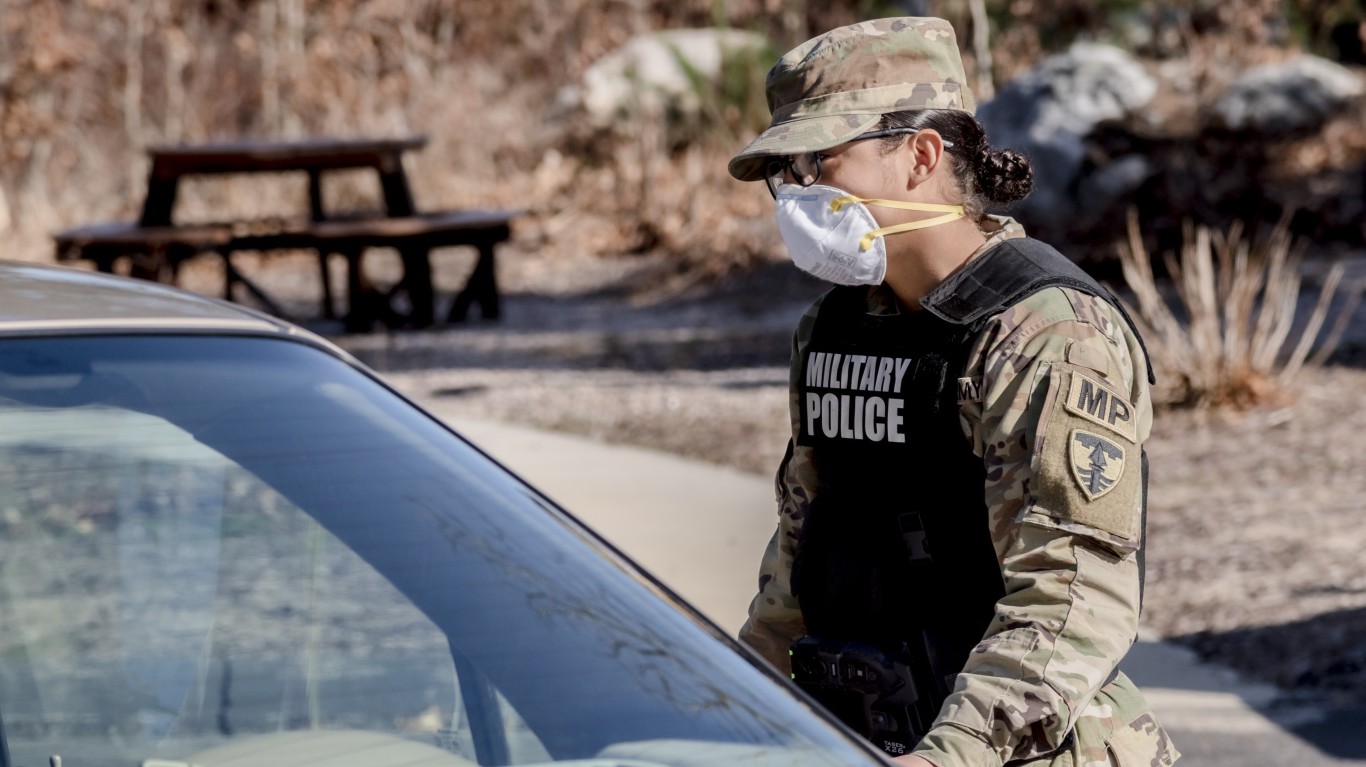
Rhode Island
> Confirmed COVID-19 cases as of June 4: 1,439 per 100,000 people — 4th highest (total: 15,219)
> COVID-19 related deaths as of June 4: 70 per 100,000 people — 5th highest (total: 742)
> Tests as of June 4: 15,373 per 100,000 people — the highest (total: 162,540)
> Date of first confirmed case: 3/1/2020
> Est. peak date: 5/5/2020 (est. 1,650 active infections)
> Population: 1,057,315
The stay-at-home order expired on May 8. The state entered Phase 2 of its reopening plan on June 1. Social gatherings are limited to 15 people. Offices can open but to no more than 33% capacity. Working from home, though, is still encouraged. State park and beaches are now open, but capacity is limited and people must stay at least 6 feet apart.
Malls, hair salons, barbershops, and other businesses that offer personal services can reopen with restrictions as well. Gyms, fitness studios, and small group fitness classes are allowed to reopen but with limited capacity. Communal areas are to remain closed, and 6-foot social distancing must be established between equipment.
[in-text-ad-2]

South Carolina
> Confirmed COVID-19 cases as of June 4: 249 per 100,000 people — 14th lowest (total: 12,651)
> COVID-19 related deaths as of June 4: 10 per 100,000 people — 21st lowest (total: 518)
> Tests as of June 4: 4,537 per 100,000 people — 22nd lowest (total: 230,687)
> Date of first confirmed case: 3/6/2020
> Est. peak date: 4/15/2020 (est. 1,203 active infections)
> Population: 5,084,127
The stay-at-home expired on May 4. Orders for out-of-state visitors to quarantine have also expired. Retail stores are under instructions to operate at limited capacity. Residents are encouraged, but are no longer required by law, to work from home. Restaurants can choose to reopen for limited dine-in services if they follow state guidelines, including limiting indoor occupancy to 50%. Outdoor customer dining services are also allowed. Youth and adult sports leagues started practicing on May 30, but competition will be permitted to resume June 15.
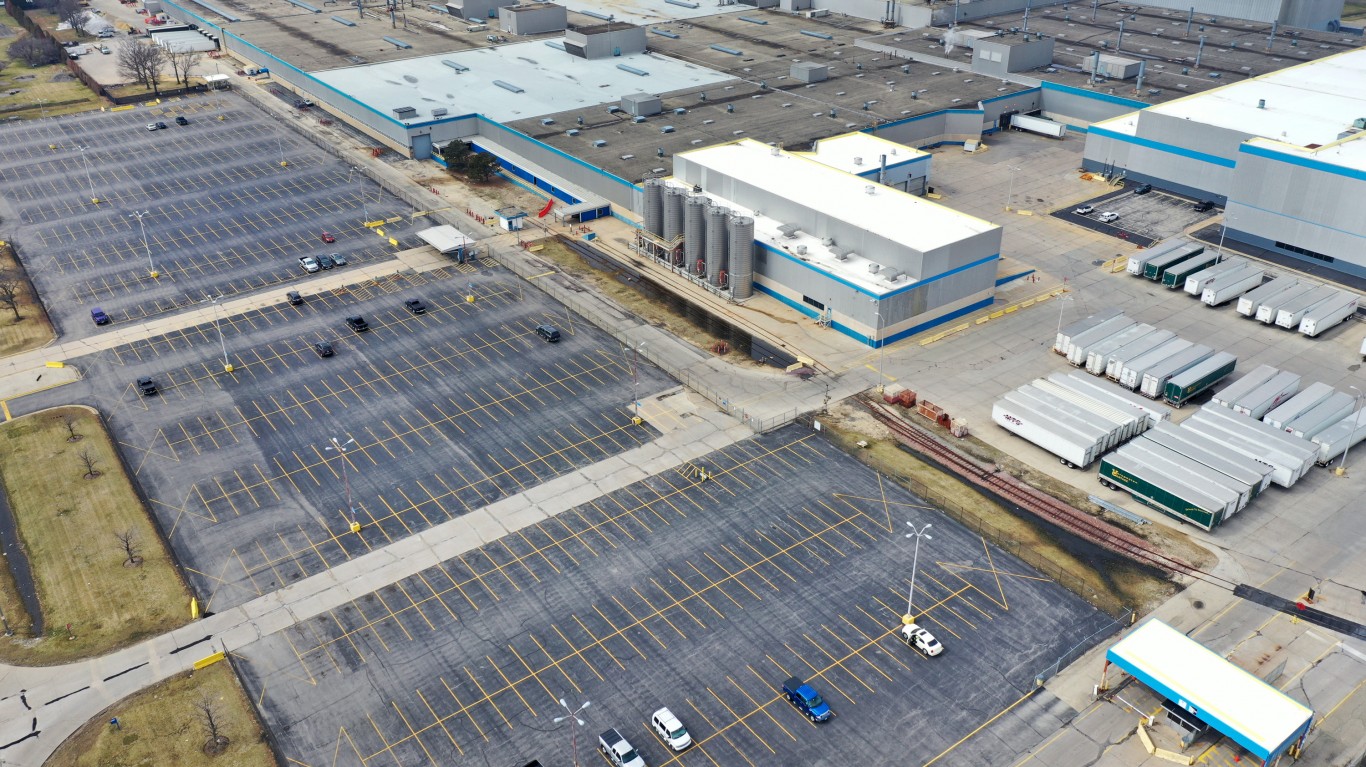
South Dakota
> Confirmed COVID-19 cases as of June 4: 585 per 100,000 people — 12th highest (total: 5,162)
> COVID-19 related deaths as of June 4: 7 per 100,000 people — 12th lowest (total: 62)
> Tests as of June 4: 5,516 per 100,000 people — 19th highest (total: 48,662)
> Date of first confirmed case: 3/10/2020
> Est. peak date: 4/21/2020 (est. 234 active infections)
> Population: 882,235
The state never issued a statewide stay-at-home order, but it did institute some restrictions on gatherings and businesses. An order that required state residents to observe social distancing and CDC-recommended hygiene practices expired on May 31, but the state of emergency has been extended until December 30.
Nonessential medical procedures were postponed through the end of May. Businesses are now allowed to reopen if the surrounding area has reported a downward trend in cases for two weeks. Employees can now be called back to the office, though administrative leave is allowed for those who cannot come in and cannot work remotely.
[in-text-ad]
Tennessee
> Confirmed COVID-19 cases as of June 4: 367 per 100,000 people — 23rd highest (total: 24,822)
> COVID-19 related deaths as of June 4: 6 per 100,000 people — 10th lowest (total: 388)
> Tests as of June 4: 6,954 per 100,000 people — 12th highest (total: 470,779)
> Date of first confirmed case: 3/5/2020
> Est. peak date: 3/23/2020 (est. 937 active infections)
> Population: 6,770,010
The stay-at-home order expired on April 30. A safer-at-home order was in effect until May 29. Many businesses have been allowed to open in the meanwhile. Restaurants can offer in-person but limited-capacity dining. Noncontact sports, like baseball, golf, or tennis, were allowed to resume on May 22, as was higher education.
Groups of up to 50 people can now participate in social and recreational gatherings if they practice social distancing. The most populated areas of the state will decide when to reopen on their own.
Texas
> Confirmed COVID-19 cases as of June 4: 232 per 100,000 people — 12th lowest (total: 66,568)
> COVID-19 related deaths as of June 4: 6 per 100,000 people — 11th lowest (total: 1,698)
> Tests as of June 4: 3,436 per 100,000 people — 13th lowest (total: 986,224)
> Date of first confirmed case: 2/12/2020
> Est. peak date: 4/26/2020 (est. 4,656 active infections)
> Population: 28,701,845
The stay-at-home order expired on April 30. Zoos and water parks were allowed to reopen on May 29 at a limited capacity. Bars, as well as aquariums and natural caverns, were allowed to open after May 22. Barbershops, hair salons, and tanning salons were allowed to resume operations starting on May 8. Gyms reopened starting May 18 at 25% occupancy, and recreational sports programs were allowed to start May 31. Pro sports events were also allowed May 31, with 25% capacity, for outdoor venues. Recreational sports practices for adults have resumed, but games and competitions can begin June 15. All air travel restrictions, including mandatory quarantines for out-of-state travelers, have been lifted.
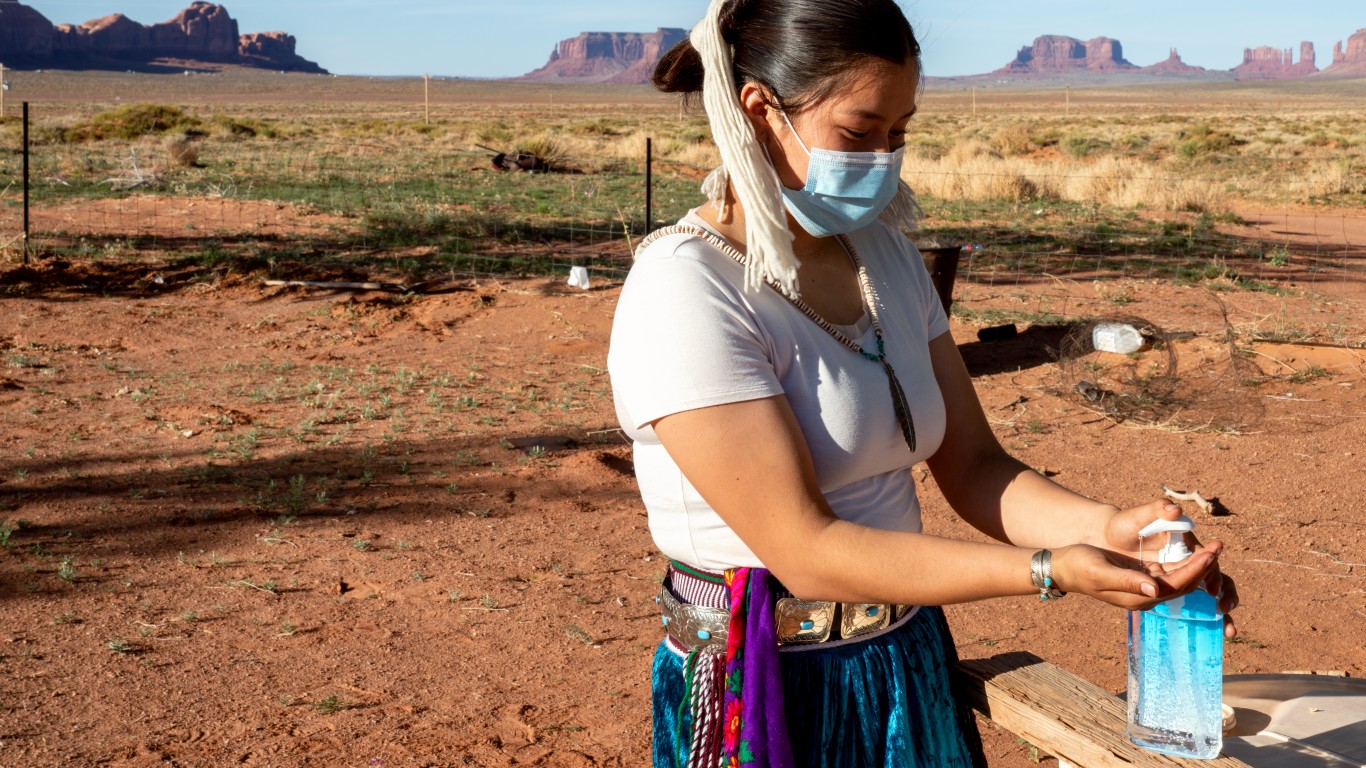
Utah
> Confirmed COVID-19 cases as of June 4: 332 per 100,000 people — 23rd lowest (total: 10,497)
> COVID-19 related deaths as of June 4: 4 per 100,000 people — 5th lowest (total: 117)
> Tests as of June 4: 7,086 per 100,000 people — 11th highest (total: 223,981)
> Date of first confirmed case: 2/25/2020
> Est. peak date: 6/1/2020 (est. 412 active infections)
> Population: 3,161,105
The state never issued a statewide stay-at-home order. The stay safe, stay home directive expired on May 1. In-restaurant dining, gyms, and salons can now open. Gatherings of up to 20 people are allowed. Statewide restrictions on elective surgeries and procedures were lifted as of April 21.
Malls and national parks can reopen under tight restrictions. Hours may vary and occupancy might be limited. People are still encouraged to avoid nonessential travel. College campuses may be open for in-person classes with increased cleaning and hygiene regimen.
[in-text-ad-2]
Vermont
> Confirmed COVID-19 cases as of June 4: 164 per 100,000 people — 8th lowest (total: 1,026)
> COVID-19 related deaths as of June 4: 9 per 100,000 people — 17th lowest (total: 55)
> Tests as of June 4: 6,041 per 100,000 people — 15th highest (total: 37,834)
> Date of first confirmed case: 3/7/2020
> Est. peak date: 3/17/2020 (est. 156 active infections)
> Population: 626,299
The stay-at-home order expired on May 15. The state of emergency was extended until June 15. Everyone has to work remotely when possible. As of May 11, construction has been fully allowed as long as safety measures — wearing masks and practicing good hygiene — are followed. Retail and lodging businesses can start reopening. Hair salons and barbershops can reopen but by appointment and with limits on occupancy. Transactions must be cashless and touchless, and owners must keep a customer log in case contact tracing is needed later. As of May 22, restaurants and bars have been allowed to open with limited outdoor seating.
Virginia
> Confirmed COVID-19 cases as of June 4: 536 per 100,000 people — 16th highest (total: 45,620)
> COVID-19 related deaths as of June 4: 16 per 100,000 people — 21st highest (total: 1,338)
> Tests as of June 4: 4,125 per 100,000 people — 17th lowest (total: 351,354)
> Date of first confirmed case: 3/7/2020
> Est. peak date: 4/13/2020 (est. 3,625 active infections)
> Population: 8,517,685
A stay-at-home order is in effect until June 10. All counties were allowed to begin reopening as of May 28, though Gov. Ralph Northam said the state would not move into Phase 2 until June 5 at the earliest. In Phase 2, restaurants can provide indoor dining at 50% occupancy, and fitness centers can open indoor areas at 30% occupancy. Museums, zoos, aquariums, gardens, and outdoor sporting and performance venues can open with restrictions. Swimming pools may expand operations to indoor and outdoor exercise. Diving and swimming instruction can resume as well in Phase 2.
[in-text-ad]
Washington
> Confirmed COVID-19 cases as of June 4: 298 per 100,000 people — 20th lowest (total: 22,484)
> COVID-19 related deaths as of June 4: 15 per 100,000 people — 22nd highest (total: 1,135)
> Tests as of June 4: 5,007 per 100,000 people — 25th highest (total: 377,327)
> Date of first confirmed case: 1/21/2020
> Est. peak date: 3/24/2020 (est. 2,770 active infections)
> Population: 7,535,591
A stay-at-home, stay healthy order was in effect until May 31 and since it has been replaced by a Safe Start reopening plan. Most of the state’s counties are in Phase 2 of reopening, in which restaurants, salons, and stores can open in a limited capacity. In-person real estate activities such as sales and appraisals with up to three people and fitness and training services have been allowed to resume since May 19 in counties that are in Phase 2 of reopening.
West Virginia
> Confirmed COVID-19 cases as of June 4: 112 per 100,000 people — 6th lowest (total: 2,018)
> COVID-19 related deaths as of June 4: 4 per 100,000 people — 7th lowest (total: 78)
> Tests as of June 4: 5,778 per 100,000 people — 17th highest (total: 104,333)
> Date of first confirmed case: 3/17/2020
> Est. peak date: 4/6/2020 (est. 224 active infections)
> Population: 1,805,832
The stay-at-home order expired on May 3. A safer-at-home order is now in effect. Residents are encouraged but not required to stay inside. The primary elections were moved from May 12 to June 9. As of May 26, West Virginia was in its fifth week of its reopening plan, allowing state park cabins, museums, and zoos to reopen. Bars are also allowed to serve at 50% capacity.
Since May 30, spas and massage businesses have been allowed to open. The same applies to swimming pools, bowling alleys, pool halls, roller rinks, and other indoor amusement venues. Movie theaters will be permitted to reopen on June 5. Out-of-state visitors are no longer required to self-quarantine.
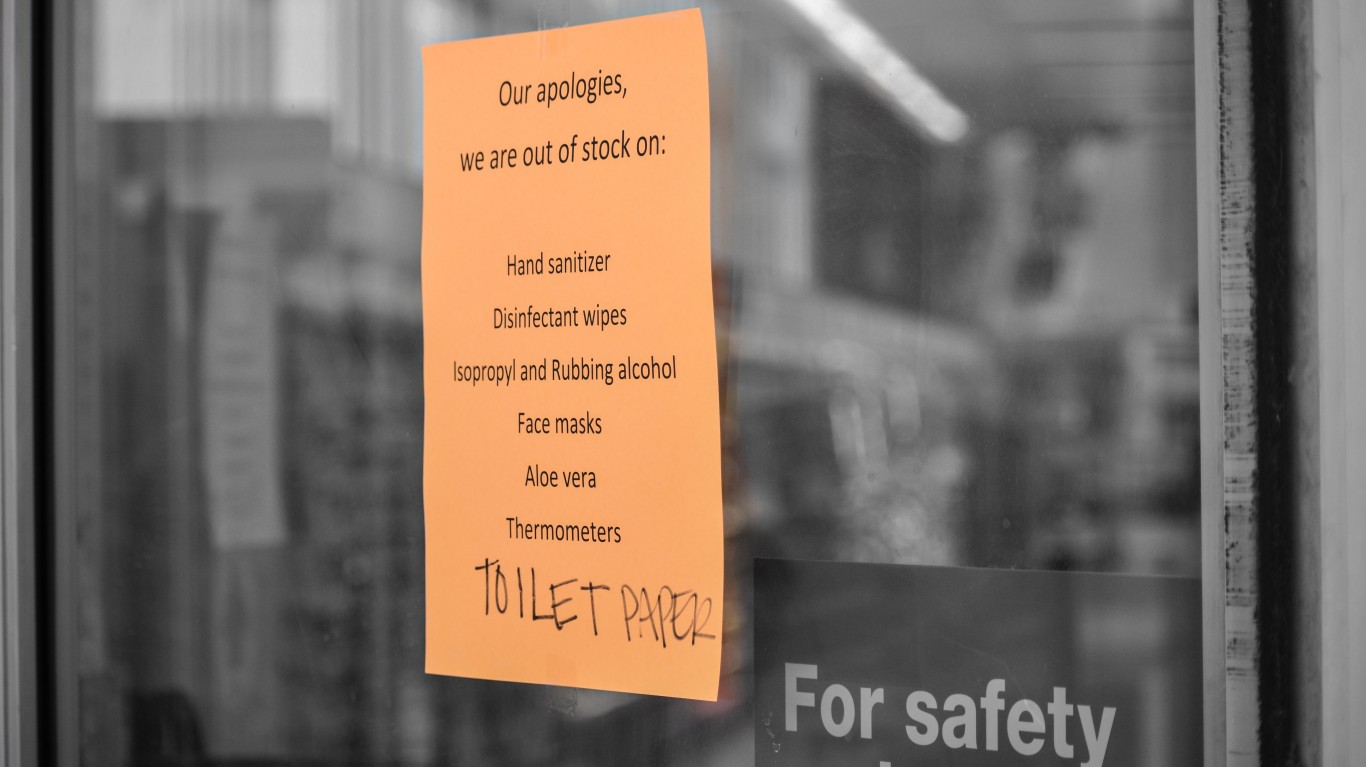
Wisconsin
> Confirmed COVID-19 cases as of June 4: 334 per 100,000 people — 24th lowest (total: 19,400)
> COVID-19 related deaths as of June 4: 11 per 100,000 people — 22nd lowest (total: 616)
> Tests as of June 4: N/A
> Date of first confirmed case: 2/5/2020
> Est. peak date: 3/30/2020 (est. 1,312 active infections)
> Population: 5,813,568
A stay-at-home order was supposed to be in effect until May 26, but the state’s Supreme Court struck it down on May 13. All restrictions were then lifted. Some districts have imposed their own stay-at-home orders, though most have lapsed throughout May.
[in-text-ad-2]
Wyoming
> Confirmed COVID-19 cases as of June 4: 158 per 100,000 people — 7th lowest (total: 915)
> COVID-19 related deaths as of June 4: 3 per 100,000 people — 4th lowest (total: 17)
> Tests as of June 4: 4,473 per 100,000 people — 21st lowest (total: 25,843)
> Date of first confirmed case: 3/11/2020
> Est. peak date: 5/8/2020 (est. 93 active infections)
> Population: 577,737
The state never issued a statewide stay-at-home order. Gyms, barbershops, hair salons, other personal care services, and elective surgeries have resumed with limits on the number of customers in the facility. Gatherings of up to 25 people are now allowed. Restaurants can start offering indoor and outdoor dining. Movie theaters and performance venues can reopen with no more than 25 people. Gyms can reopen locker rooms, offer personal training, as well as group classes for up to 20 participants. Child care facilities can allow up to 25 people in a classroom.
If you’re one of the over 4 Million Americans set to retire this year, you may want to pay attention.
Finding a financial advisor who puts your interest first can be the difference between a rich retirement and barely getting by, and today it’s easier than ever. SmartAsset’s free tool matches you with up to three fiduciary financial advisors that serve your area in minutes. Each advisor has been carefully vetted, and must act in your best interests. Start your search now.
Don’t waste another minute; get started right here and help your retirement dreams become a retirement reality.
Thank you for reading! Have some feedback for us?
Contact the 24/7 Wall St. editorial team.